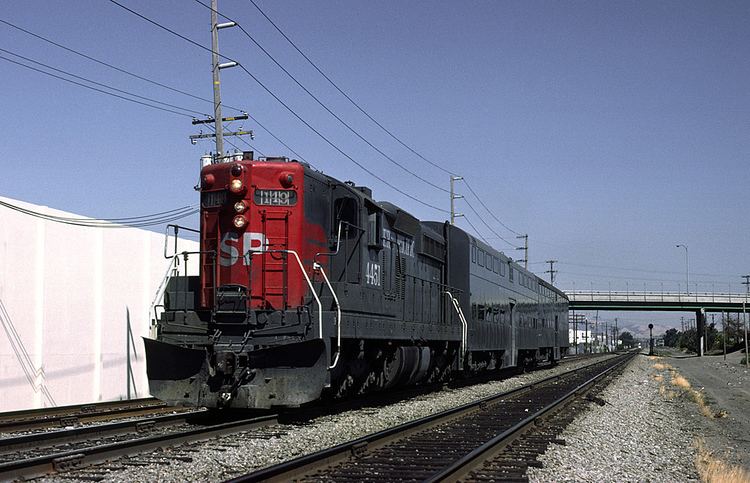Number of stations 32 | Number of lines 1 | |
 | ||
Area served San Francisco PeninsulaSanta Clara Valley Locale San Francisco, San Mateo, and Santa Clara | ||
The Peninsula Commute, also known as the Southern Pacific Peninsula or just Peninsula, was the common name for commuter rail service between San Jose, California and San Francisco, California on the San Francisco Peninsula. This service ran as a private, for-profit enterprise beginning in 1863. Due to operating losses, the Southern Pacific Railroad (SP) petitioned to discontinue the service in 1977. Subsidies were provided through the California Department of Transportation (Caltrans) in 1980 to continue service, and it was renamed Caltrain.
Contents
History
Since 1863 the San Francisco Peninsula, the series of towns (and later, cities) between San Francisco and San Jose, has been served by a railroad. The Southern Pacific first provided freight and passenger service, followed briefly by the California Department of Transportation (Caltrans) and finally a Joint Powers Board which runs today's passenger trains.
San Francisco–San Jose Railroad
Although a line had been proposed in the past, construction on the railroad between San Francisco and San Jose was started in 1860 "by a group of local capitalists of more than ordinary energy and resources" under the auspices of the San Francisco and San Jose Rail Road (SF&SJ), and completed in 1863. The Central Pacific Railroad transferred its rights for the construction of the right-of-way between San Jose and Sacramento to the Western Pacific Railroad (WPRR, which was founded by the same members that had founded the SF&SJ) in late 1862.
In December 1865, the Southern Pacific Railroad Company (SP) was incorporated to build a rail line between San Francisco and San Diego. The "Big 4" of Stanford, Huntington, Hopkins and Crocker showed a controlling interest in the SF&SJ and SP by the end of 1868, and the SF&SJ, SP, the Santa Clara and Pajaro Valley Railroad, and the California Southern were folded into a consolidated Southern Pacific Railroad on October 12, 1870.
Under Southern Pacific
Under Southern Pacific the line was double tracked in 1904 and had record ridership during World War II. During the war, 26 trains ran between San Jose and San Francisco, with headways as low as 5 minutes (traveling north) in the mornings and 3 minutes (traveling south) in the evenings.
A May 1946 railroad strike displaced approximately 10,000 train riders onto highways, causing "historic" traffic jams along the Bayshore Highway, with auto commute times for some travelers from Burlingame to San Francisco, a distance of approximately 19 miles (31 km), to balloon from 30 minutes to 75 minutes. However, after the war, roads were improved, with the four-lane undivided Bayshore Highway (completed in 1925) becoming a six-lane divided freeway between 1949–1962, and Interstate 280 was added in the 1970s. Train ridership declined with the rise of automobile use.
Several times during the 1960s and 1970s, SP talked about discontinuing the commute service due to increasing deficits and flat ridership. Ridership was 11,500 daily passengers on 22 trains in 1970, compared to 12,000 daily passengers in 1967 and 10,000 daily passengers in 1946. In 1971 when Amtrak took over long distance passenger operations, Southern Pacific's extended commute train to Monterey, California, the "Del Monte", was discontinued, but other commute trains continued. All SP passenger locomotives were transferred to Peninsula commute service except for those which were sold to Amtrak.
Operating deficits were mounting, from US$670,000 (equivalent to $5,174,000 in 2016) in 1964 to over US$1,000,000 (equivalent to $6,890,000 in 2016) by 1968, US$5,300,000 (equivalent to $23,590,000 in 2016) by 1975, and US$9,000,000 (equivalent to $37,880,000 in 2016) just one year later in 1976 according to an independent review, which prompted SP to petition the California Public Utilities Commission (CPUC) for a fare increase of 111 percent, as fares had increased minimally and ridership, approximately 12,000 passengers per day in 1967 was not increasing, despite the fuel crisis. The slow decision process prompted SP's then-president, Benjamin Biaggini, to offer to purchase 1,000 eight-passenger vans and donate them for vanpools in order to discontinue the Peninsula Commute trains entirely. In 1977 SP filed a petition with the CPUC to discontinue the commuter operation due to the ongoing losses. At that time, SP was running 44 trains a day.
State administration and Caltrain
To preserve the commuter service, Caltrans took over financial responsibility on July 1, 1980 (1980-07-01), and contracted with SP to operate the service. During the Caltrans administration, Caltrans purchased new locomotives and cars that replaced the SP equipment in 1985, upgraded stations, introduced shuttle buses to nearby employers, and renamed the operation Caltrain. The Peninsula Corridor right-of-way was purchased for US$202,000,000 (equivalent to $355,200,000 in 2016) from SP in 1991 by the newly-formed Peninsula Corridor Joint Powers Board (PCJPB), who subsequently assumed responsibility for the operation of Caltrain in 1992.
